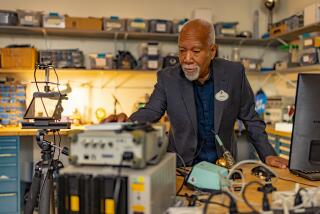With 3-D printers, solid objects may be several clicks away
- Share via
At its most basic level, a 3-D printer is like an automated hot-glue gun programmed to spit out solid objects. The machines extrude layers of plastic into virtually any three-dimensional shape. Print whimsical garden statuary. Reproduce an anatomically correct heart with moving parts for your son’s science project (actually, he could do that himself). Create a signature bookend, cookie cutter, necklace — anything.
The buzz within the design world is that most homes could have one of these gadgets within 10 years. The 3-D printers are billed as transformational technology, poised to upend traditional manufacturing and usher in a new made-at-home era.
To launch a new Saturday section series on technology that’s changing the face of home DIY, I tested the Solidoodle 2, one of the less costly 3-D printers aimed at early-adopter design enthusiasts. The Solidoodle 2 is $499 and comes with a “build area,” the maximum size object it can create, of a 6-inch cube. (A third-generation Solidoodle is $799 and has a build area of an 8-inch cube.)
I chose to design and print a coaster — quite the aesthetic challenge, I know. But I wanted to try a simple object, especially after opening the Solidoodle 2 box to reveal an imposing, industrial-looking robotic device.
I designed my coaster using SketchUp, a free, easy-to-learn 3-D modeling program. Even novices can draw shapes and have them rendered in 3-D — a perfect tool for creating my humble coaster.
I sketched a 3/8-inch-thick disk with a raised, half-crescent edge, matched by a cutout crescent on the opposite edge. In the center, I drew a Piet Mondrian-inspired Pop art design, with shapes inlaid to a depth of 1/16 inch or 1/8 inch.
My coaster was exquisite, like ones sold in museum gift shops (at least I thought so). I fantasized about creating a page on the craft marketplace Etsy and taking bulk orders. I envisioned manufacturing democratized, right on my kitchen table.
Excited by my turn in fortune, I downloaded and installed the Solidoodle open-source software that has been updated with easier-to-use default settings, according to the year-old, Brooklyn-based company.
Next, I needed to convert my SketchUp file into an STL file, a universal file format, like JPEG and PDF. After successive attempts and an hour of tech support, the needed plug-in simply wouldn’t plug in. The Solidoodle employee was helpful, but he said the process of coordinating printers, computers and software could be a “weirdly non-intuitive process.” I agreed.
He assured me, however, that most Solidoodle users are able to use SketchUp and other software to design objects, adding that my computer errors were “rare and exotic.”
I gave up. I turned to Thingiverse.com, an online world where 3-D printer enthusiasts share their STL files — designs as varied as a rubber ducky with a devilish grin and a replacement valve for a drip coffee maker. I chose a coaster.
Next I needed to “slice” my coaster, converting the STL file into dimensional layers that the printer could read. I did so using Skeinforge, downloaded with the Solidoodle software.
Solidoodle is compatible with Mac and Windows. I connected my MacBook Pro to the printer using the USB cable included in the box, but the printer wouldn’t recognize my laptop port. Another hour of tech support revealed that I needed to install “Arduino drivers.” (Still with me?)
Next, from a control window I heated the extruder nozzle to 200 degrees and the bed platform to 85, so the melted plastic would stick to it. I then loaded the ABS plastic filament line to the nozzle. Solidoodle’s website instructions were clear and simple.
I loaded my coaster’s leaf-shaped design and — at long last — hit “print.”
The nozzle began its programmed dance, firing out the design. I felt like Alexander Graham Bell.
A minute later, though, the nozzle zoomed to the right and dripped hot plastic onto thin air and down the edge of the platform below. I pulled the plug.
Turns out I needed to center the design in something called the ReplicatorG software. (Solidoodle’s instructions said that might be necessary.) I installed the ReplicatorG software, centered the design and hit “print” again, but this time the nozzle began scraping away layers of plastic instead of laying them down. I pulled the plug again.
“All this for a bloody coaster?” my partner howled.
I ignored him. I had forgotten to reheat the building platform to 85 degrees, causing adhesion problems. I started again.
My third attempt produced the coaster. I watched as the printer laid down lines of plastic, noodling the center with a semi-hollow, honeycomb pattern. Print time: 40 minutes.
The quality of the finished design seemed a bit crude. The default print resolution is 0.3 millimeter, meaning each layer of plastic is 0.3 mm thick. A higher resolution, 0.1 mm would have been better.
Once the printing began, however, the angst-ridden setup was a memory, replaced by the triumph of printing an actual object — albeit not one you’d ever see in a museum gift shop.


